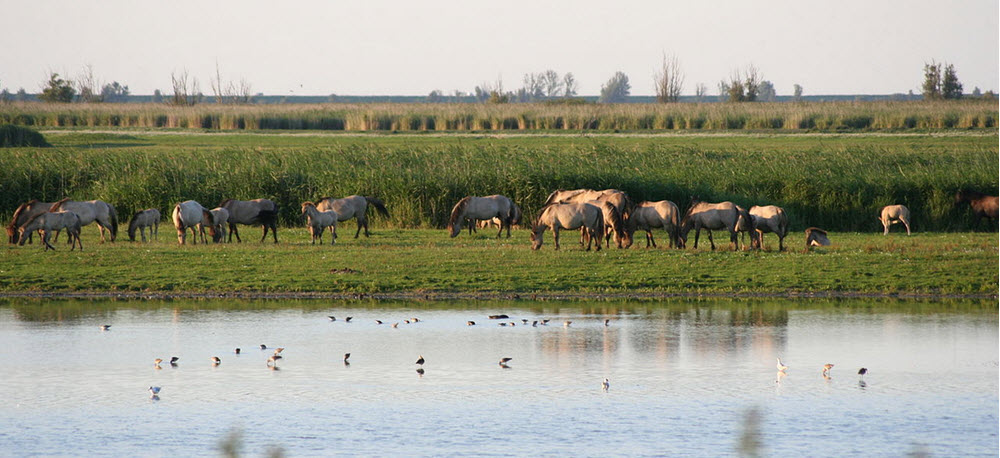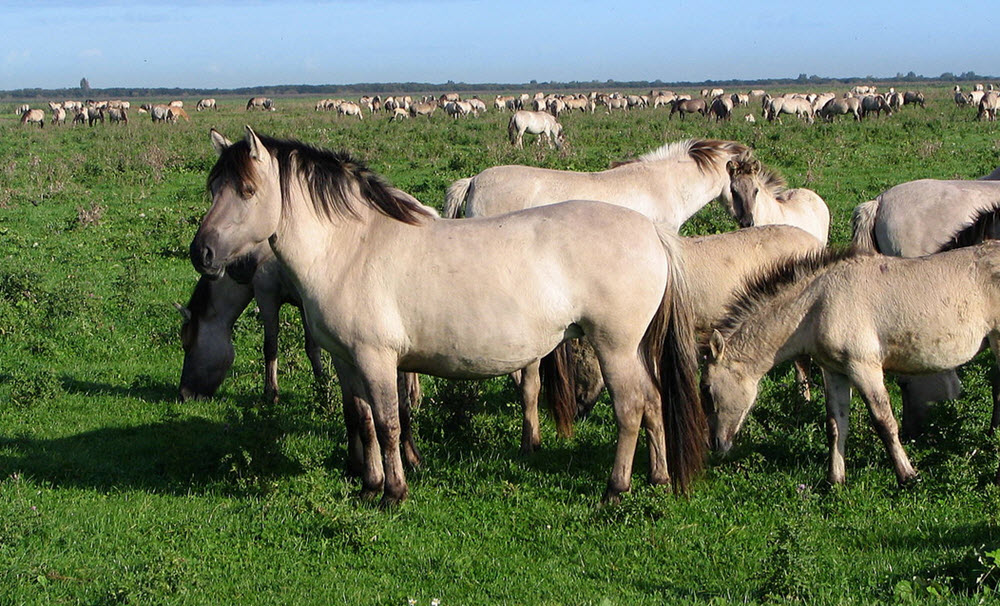Oostvaardersplassen
Contents
Oostvaardersplassen is a 56-square-kilometre nature reserve in the Netherlands. Located by the coast, within a polder created in 1968, the land was declared a Ramsar wetland in 1989. It then became a part of the Nieuw Land National Park when it was established in 2018.

Oostvaardersplassen, which is managed by Staatsbosbeheer (the State Forestry Service), has received a lot of attention for its rewilding projects. It has also incurred harsh criticism for letting large numbers of grazing animals starve to death (or being shot to prevent this) during harsh winters, as the reserve is fairly small and a fence prevents the animals from migrating to better conditions.
There are no large predators present in Oostvaardersplassen. The lack of predators such as wolf and bear allows the populations of grazing animals to grow unnaturally large.
Where is Oostvaardersplassen?
Oostvaardersplassen is located in the Province of Flevoland in the Netherlands, on the shore of the Markermeer in the centre of the Flevopolder.
Coordinates: 52°27′N 5°22′E
The closest city is Lelystad, as the park is found between Lelystad and Almere.
Wet & Dry environments
The Oostvaardersplassen contain both dry land and wetlands. Generally speaking, the park is much wetter in the north-east and much dryer in the south-east.
In the north-east – along the shallow lake Markermeer – there is a wet area dominated by large reedbeds growing on clay. It is a popular space for birds such as geese, great egret, Eurasian bittern, common spoonbill, great cormorant, and white-tailed eagle.
The drier part of the park has a history of being a nursery for willow trees. When the land was turned into a park, the ground was still filled with an abundance of willow seedlings, and there was a risk that the area would simply turn into a dense willow woodland if left on its own. This would not be beneficial for the waterfowl, so park management introduced large herbivores – including red deer, Heck cattle and Konik ponies – to the area to prevent a forest from forming. The general idea is to encourage the type of ecosystem that existed along riverbanks and deltas in the area before human intervention.
Konik ponies and Heck cattle are both domestic animals, but they are hardy and was selected to fill the niche that would, in the past, have been filled by now extinct animals such as Tarpan horse and Aurochs cattle.
In addition to Konik ponies and Heck cattle, the Oostvaardersplassen is home to red deer and roe deer. Alces alces elk and wisent might be introduced in the future, since they used to be a part of the large herbivore fauna in this part of Europe.
Top predators
Large predators such as wolfs, bears and lynx do not live in Oostvaardersplassen, which has caused some discussion about exactly how ”natural” the ecosystem can be said to be.
Management
The nature preserve is located within a polder and surrounded by fences, preventing animals from moving away if food becomes to scarce. Also, there are no large predators present to keep the herd sizes down. The large number of large grazing animals that have either starved to death in the park or been shot to prevent starvation has become a controversial subject in the Netherlands.
One notable example is the winter of 2017-2018 when approximately 3,300 deer, cattle and horses starved to death in the park. After public outcry, a new culling strategy was imposed by park management.
A noted problem for the preserve is that it has not been able to connect to the nearby Veluwe, a 1,100 square kilometres ridge of hills in the province of Gelderland, where the landscape includes both woodland, heath and sand drifts.
Future green corridors
The creation of green corridors connecting Oostvaardersplassen to other areas of wilderness have been suggested, but not yet materialized. One of the most feasible suggestions is the creation of a corridor to nearby Horsterwold. In the Ecological Main Structure Plan, the suggestion is to use a corridor to connect both areas and call the resulting network the Oostvaardersland. A connection would permit seasonal migration to the more sheltered Horsterwold area for the winter, and the animals would be likely to willingly return to Oostvaardersplassen for the summer season when there is plenty of food available there and the sea winds keep biting insects at bay near the coast. In total, Ostervaardersland would cover 150 sq km of land.
The creation of Oostervaardersland was originally planned to be completed by 2014, but the project lost political support and ran into economic difficulties. In 2012, the creation of the corridor (dubbed ”Oostervaarderswold”) was stopped and four members of the regional parliament resigned.
De Nieuwe Wildernis
De Nieuwe Wildernis (English: The New Wilderness) is a 2013 Dutch documentary film about Oostvaardersplassen. The film follows the park during four seasons and is based on two years of filming.

Animals
A few examples of animals that are shown in the film:
- Konik horse
- Red deer
- Red fox
- Eurasian beaver
- Brown rat
- Natterjack toad
- Common frog
- Common carp (fish)
- Large earth bumblebee
- Spring mining bee
- Yellow dung fly
- White-tailed eagle
- Common buzzard
- Common raven
- Common kingfisher
- Common nightingale
- Great cormorant
- Great crested grebe
- Great egret
- Greylag goose
- Barnacle goose
- Mute swan
- Eurasian spoonbill
Awards
- Film Poster Award (2013) at the Netherlands Film Festival
- Golden Film (2013) for 100,000 visitors
- Platinum Film (2013) for 400,000 visitors
- Rembrandt Award for Best Dutch Film (2014)
- Golden Calf for Best Popular Film (2014) at the Netherlands Film Festival